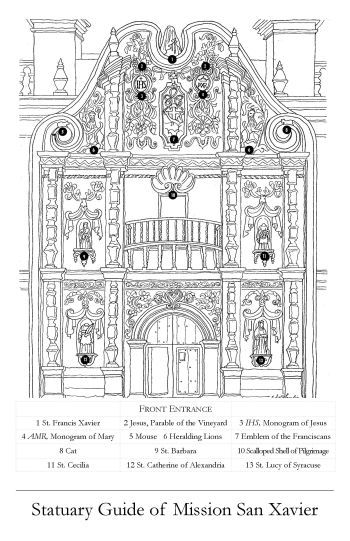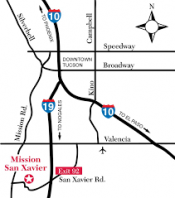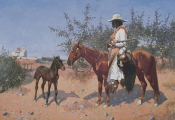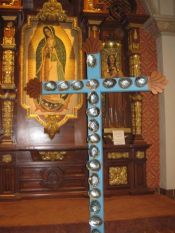Mission San Xavier del Bac
Kino's Querencia
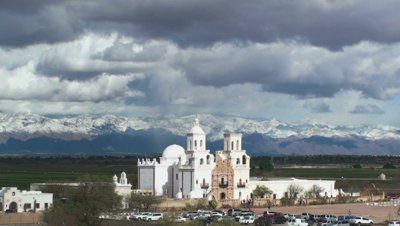
Mission San Xavier del Bac and Santa Catalina Mountain Range
Mission San Xavier del Bac
Mission San Xavier del Bac was founded by Padre Kino in 1692 and continues to serve today's O'odham People as an active parish church. The mission is located 9 miles south of downtown Tucson on the San Xavier District of the O'odham Nation in the community of Wa:k.The former San Xavier Indian Reservation was estatblished in 1874 by President Grant.The presence of its Mission church helped in the protection of this small part of O'odham traditional lands.
The Mission's Moorish architecture and its Baroque art is the finest example of a Spanish Colonial style building in the United States. It is visited by tens of thousands of people annually from around the world - many who travel as pilgrims. As author Kathleen Walker observes in "Mission San Xavier de Bac: The Spirit Endures" the church is not a museum of the past but is a living church where people - be they parishoners, global visitors or pilgrims - come in peace and fellowship.
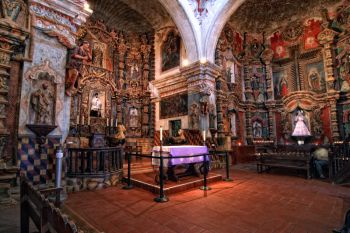
Sanctuary and East Chapel
Kino's Utopian Vision
"But the greatness of new missions will shine not only in the eternity of heaven, but also in the most desolate and remote regions of the world. It will live on in the splendid construction of temples, churches, buildings and houses. It will reflect in the solemnities of the saints, in gay fiestas, and in the treats of religious banquets; it will be heard in music and the choirs of singers. It will be seen in the bountiful, spiritual and temporal wealth of opulent missions which, with reason, will be a source of pride."
Kino's Biography of Francisco Javier Saeta
Book 8 Chapter 6
Eusebio Francisco Kino 1695
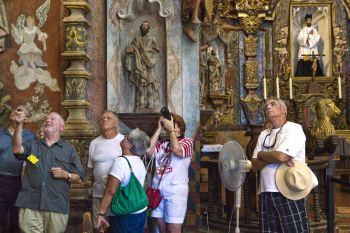
Mission Tour lead by John Carhuff of the Patronato San Xavier.
Photo by Ron Medvescek / Arizona Daily Star
Mission Preservation
Patronato San Xavier
The Patronato San Xavier is a nonsectarian, nonprofit 501(c)(3) organization founded by Southern Arizona community leaders in 1978. The Patronato’s only purpose is to promote the restoration, preservation and maintenance of the Mission's buidlings. This Mission is a United States Historic Landmark and was named to the global World Monuments Fund “Watch” list of cultural heritage sites at risk.
Since its founding in 1978, Patronato has raised more than $11 million for the restoration of the exterior and conservation of its interior of Mission San Xavier. Much more remains to be done. The Patronato sponsors an annual Christmas and Spring concert in the church. Patronato speakers are available for public presentations. More about the Patronato at → https://patronatosanxavier.org/
Mission Tours
Patronato San Xavier
Monday through Saturday when the church is not in use, the Patronato San Xavier offers visitors free docent-led tours of the Mission several times a day. The docents are community volunteers trained in the history, architecture, and culture of the Mission and its surroundings. Each tour is approximately 45 minutes, begins at the museum entrance, and requires no advance registration. Group tours and educational tours are provided with advance scheduling.
For Docent Tour Hours
Click → https://patronatosanxavier.org/visit/
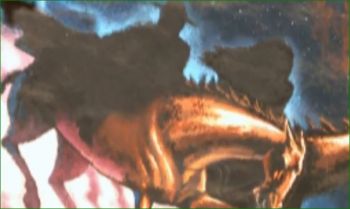
Kino's 20 Hour 75 Mile Ride For Justice
Blue Shell Conference at San Xavier and Kino’s Ride for Justice
Summary Account
Charles W. Polzer
Kino kept thinking about the simple, precious gift the sturdy Yumans had given him at San Pedro those blue abalone shells. Those shells were seen by him only once, fifteen years before on the mapping expedition to the "opposite shore" of the Isla de California!
While Padre Eusebio was at Remedios, a chieftain from the Gila Pimas arrived with news of the river peoples and a cross strung with 20 blue shells, a gift from the governor of the Cocomaricopas.
Kino pulled up at San Xavier del Bac. With the question of the shells very much on his mind, he decided to send out inquiries about the origins of the blue shells. Runners went north, west and even east to call the great chiefs to a "Blue Shell Conference" at Bac.
In a matter of days the Padre's messages got a response; chiefs and couriers came with the certain information that the blue shells from the Yuma's could not have come from the Gulf because the blue-crusted abalone didn't occur in those dense waters. They had been traded hand to hand from the distant Pacific.
While waiting for the replies, Kino devoted his time to instructing the Sobaípuris in the catechism, and, true to his nature, he directed the laying of foundations for a large church. It was time to petition for a permanent transfer to Bac.
He saddled up and rode south toward Dolores. At dawn on May 3, Kino was preparing to say Mass at San Cayetano de Tumacácori when he was handed a letter from Father Campos at San Ignacio. It was an urgent summons for him to intervene in the scheduled execution, May 4, of a prisoner in the custody of the soldiers. Riding until midnight, he rested at Imuris, reaching San Ignacio at sunrise - just in time to celebrate Mass and save a poor Piman from death.
Permission was granted for the transfer to Bac - he only needed to wait for a replacement, a replacement that never ever came. With confidence and expectation at that time Kino dispatched 700 head of livestock to restart the mission farms at Bac and he set about making plans for an expedition to the Colorado.”
Charles W. Polzer, S.J.
"Kino: A Legacy"
Editor Note: Based on the information shared at the Blue Shell Conference in the spring of 1700, Kino made more expeditions to the Colorado River region and its people. Kino proved that California was part of the mainland and was not an island as commonly believed. Kino’s discovery revived the missionary efforts in Baja California that Kino began in 1683. Based on his precise observations,
Kino drew his famous 1701 map of the Sonoran Desert that was published in Europe during his lifetime and used for 150 years after his death in 1711.
Blue Shell Conference at San Xavier and Kino’s Ride for Justice
Featured Article
Frank C. Lockwood
On the twentieth of March, 1700, while Kino was at Remedios, Pimas from near the Gila river brought him from the Chief of the Cocomaricopas, who lived on the Colorado river, a present of a holy cross and a string of twenty blue |83| shells. A way by land to California was now as good as discovered, for the Padre was more than ever convinced that these shells had been carried inland and overland from the Pacific, where on the western shore of California years before he had himself seen shells like these. ....
Accordingly, April 21, 1700, he started north, taking the old well-beaten route through Remedios, Cocóspera, San Lazaro, San Luis Bacoancos, Guevavi, and Tumacacori to San Xavier del Bac—the outward limit of this particular expedition. Nearly three thousand Indians had gathered to meet him here in the Santa Cruz valley; and as they were most earnest in their desire to have him remain with them he decided to do so. He at once sent word east, north, and west to leading chiefs of the Yumas, the Sobaipuris, and the Cocomaricopas requesting them to come to him here at San Xavier so that he might make diligent inquiry among them whether the blue shells could have been secured from any other place than the opposite California sea. While he awaited replies to these messages he occupied himself with |85 | teaching, baptizing, and the laying of the foundations of San Xavier Mission. By the twenty-ninth some of the chiefs began to arrive; more came on the thirtieth; and May 1 still other captains, governors, and justices—from places very remote—made their appearance. .... |135|
Only a man of extraordinary energy, resourcefulness, and power of decision—to say nothing of mental poise and bodily endurance—could have met successfully through a long series of years these burdensome and insistent demands. Kino's qualities of initiative, endurance, foresight, decision, practical judgment, cool courage, and ability to supervise great undertakings are illustrated frequently in the record of his activities set down in his letters and diaries.
As an example of what has been written above, I summarize here Kino's varied activities on a particular expedition between April 21 and May 6, 1700. This is a period of just fifteen days. He spent four days covering the one hundred and forty miles between Dolores and San Xavier. He baptized six children and a sick woman enroute; at Remedios gave orders to the Indians concerning the building of the new church; conferred with his converts at Cocóspera, surveyed the new building they were erecting, and left instructions for the roofing of the church; at San Luis Bacoancos had a conference with the local justices as well as with five others who had come from Guevavi to meet him; took note of the progress being made in crops and buildings at Guevavi and San Cayetano; and then completed the trip on the twenty-fifth with a ride of fifty miles, arriving at San Xavier after dark.
At San Xavier he heard the news that a military expedition had been sent against the Soba Indians near the Gulf. On the morning of the twenty-sixth, he sent messengers to the San Pedro River on the east, the Gila on the north, and to the Colorado far in the northwest, inviting justices, captains, and governors from these remote parts of the Pimería to meet him at San Xavier for the purpose of talking with him about the blue shells, so that he might determine with all certainty exactly where they came from and find out all he could about a land passage to California. It took a week
|136| [Image: Caption: Deserted Mission San Xavier del Bac “Notes on an Overland Journey”, Richard Bentley, 1859, Drawing by Julius Froeber]
|137| for the chief men to come in. During this time, Kino was busy each day, both morning and afternoon, in catechizing and instructing the people who gathered about him to the number of three thousand. He had three beeves killed for food, and directed the planting of a large field of corn for the church. In addition to other activities, he baptized five children on the twenty-seventh; and on the twenty-eighth began the foundations of the large church of San Xavier, supervising in person the crowd of laborers—some of whom he set to digging the foundations, others to hauling stones, and still others to mixing mortar and laying the foundation walls. April 29 he went on with the work of building and met and talked with various captains and justices who were already arriving from the San Pedro and the Gila. At sunrise on the thirtieth, a courier brought him letters from Dolores, having covered the distance of one hundred and forty miles in a day and a half and two nights. This same day the Padre made a journey to the north through San Cosme to San Augustin, to see whether there were any infants or sick people to baptize. At San Cosme he administered the rite of baptism to six children and one adult, and, at San Augustin, to three infants. Returning to San Xavier at nightfall, after his ride of ten leagues, he met many new chiefs who had arrived for the conference. They talked far into the night.
May 1, letters came to the Padre from a detachment of Spanish soldiers, then at Busánic a hundred miles to the southwest. On this same day, also, in the afternoon and evening, many more officials arrived, and again Kino spent most of the night in conversation with his Indian friends from all parts. May 2, having baptized three persons and solemnized two marriages, Kino began his return journey to Dolores, and reached San Cayetano, fifty miles distant, that night. The next morning he was up at sunrise to say mass.
There are few examples of Kino's celerity and endurance to match the activities of these first three days of May. Let it be remembered that he had been up very late on the nights of both April 30 and May 1, and that on May 2 had ridden fifty miles. Tired as he must have been from the strenuous labors of the past few days, he was now, at sunrise on May 3, called to meet an emergency that taxed |138| every power of his iron frame and resolute will. The summons was in the form of a letter from Father Campos, his fellow priest at San Ignacio. The letter stated that an unfortunate runaway Indian had been captured by the soldiers and was to be beaten to death on the morning of May 4. Campos urged Kino to come at once to help save the life of the delinquent.
Kino calmly proceeded with the morning mass, took time to reply to a letter received two days before, and then mounting his horse rode sixty-two miles to Imuris, which he reached just before midnight. Very early the next morning he said mass in San Ignacio, and then with the aid of Campos saved the Indian's life. Kino had ridden seventy miles between sunrise and sunrise, after a journey of fifty miles on the previous day. Any hardened sheriff in the wildest days of the Southwest might have been proud of such an exploit.
On May 6, the Padre was home again at Dolores.
Frank C. Lockwood
"With Padre Kino on the Trail"
The Blue Shell Conference & Kino's Ride for Justice
To View and Download Two Accounts
"A String Of Twenty Blue Shells Give The Final Clue"
"Kino as a Practical Man of Affairs"
Chapters from pp 82-86; pp 133-138
Frank C. Lockwood
Click for excerpt at
Blue Shell Conference Lockwood document (text)
Blue Shell Conference Lockwood document (pdf)
To view and download the entire Frank C. Lockwood book, click →
https://uair.library.arizona.edu/system/files/usain/download/azu_h9791k55z_l81_w.pdf
"Blue Shells - Bother or Boon?"
Chapter from "Kino: A Legacy" pp 68-70
Charles W. Polzer
Click for excerpt at
Blue Shell Conference Polzer document (pdf)
Kino's First Journey to San Xavier
Kino Accepting The Invitation of The People of Wa:k
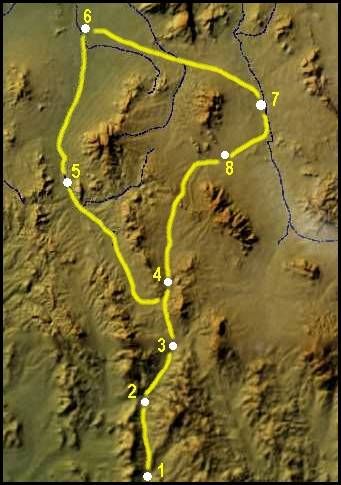
Map of Kino's First Journey to Bac-Tucson Valley & San Pedro River Valley
August 1692 to September 1692
Map Location Key
#1 Dolores; #2 Remedios; #3 Cocóspera; #4 Santa María; #5 Tumacácori; #6 Bac-Tucson Valley (Mission San Xavier del Bac); #7 Quíburi (Fairbank); #8 Huachuca (Bacocómari Ranch); Return Trip: #4 Santa María (United States-Arizona International Border); #3 Cocóspera; #2 Remedios; #1 Dolores. U.S.- Mexico Border north of #4; Interstate 19 between #5 and #6; Interstate 10 between #6 and #7.
"Wider Horizons - The Sobaípuris"
Herbert E. Bolton
The journey with Salvatierra was for Kino the prelude to a remarkable series of travels. Indeed, from now forward he became quite as much explorer as missionary. At equipping a pack train or cinching a saddle girth the padre became an expert. He had served his apprenticeship with Atondo in the exploration of the Peninsula. He now found a wider field for his skill on the trail.
When at [San Cayetano de ] Tumacácori [Christmas Season 1691], Kino had promised the messengers from Bac that he would soon return. A year later his interest was greatly quickened by a border incident. Indians stole a horse herd from a mission far to the east of Dolores. Suspicion fell on the Sobaípuris of Quíburi River (San Pedro), who for several years had been charged with depredations. Captain Ramírez with soldiers followed the trail which led to a village on that stream well north of the present Benson. [1] Ramírez was a level-headed soldier. He made peace with the |267| people, and conducted a band of chiefs to Dolores to see the already famous Black Robe. From him they begged for missionaries. "And thus," wrote Kino, "all this Pimeria is now reduced and is asking for the blessing of eternal salvation. For all this, much will always be owed to Captain Francisco Ramírez." To Ramírez's report, it may be added, we owe a good part of all that we know of the Pimas of San Pedro River down to the date when it was written. [2]
These new people were calling Kino. It was a summons he could not disregard, so he took the trail once more. He gives us a glimpse of his traveling outfit, which was elaborate and attested his efficiency. "In spite of the obstacles which were present," he says, "and seeing that the whole of Pimeria was quiet, during the last part of August and the first part of September [3] I went in with fifty pack animals, my servants, and some justices"- meaning native officials - "to the Sobaípuris, both of the north and of the northeast." What a dust he must have kicked up! "The former are in the valley and river of Santa María, to the west, the latter in the valley of the river of Quíburi, to the east. The journey to the former was more than eighty leagues by very level road."
And it was a most interesting road. As far as Tumacácori Kino retraced the trail he had traveled southward with Salvatierra. …. |268|
From here forward Kino traversed a region for which his precious record is our earliest, as is true of so many other regions that he explored. Continuing north down the river, between lofty Santa Rita on the right and lesser ranges on the left, after traveling some forty miles he entered the famous town of Bac, or Batki, -"The Place near the Well,"- named by him San Xavier after his own patron saint. San Xavier del Bac it still is called, and it is still famous. The village contained at the time more than eight hundred people.
Kino now gave the wide-eyed natives a lesson in history and geography. "I spoke to them the Word of God, and on the map of the world I showed them the lands, the rivers, and the seas over which we fathers had come from afar to bring them the saving knowledge |269| of our Holy Faith." We can see the simple folk marvel at the white man's paper which told the wonderful story. What medicine he had! "I told them also how in ancient times the Spaniards were not Christians, how Santiago came to teach them the Faith, and how the first fourteen years he was able to baptize only a few, because of which the Holy Apostle was discouraged, but that the Holy Virgin appeared to him and consoled him, promising that the Spaniards would convert the rest of the people of the world.
"And I showed them on the map of the world how the Spaniards and the Faith had come by sea to Vera Cruz and had gone into Puebla and to Mexico, Guadalaxara, Sinaloa, Sonora, and now to ... Dolores del Cosari, in the land of the Pimas, where there were already many persons baptized, a house, a church, bells, images of saints, plentiful supplies, wheat, maize, and many cattle and horses; that they could go and see it all,· and even ask at once their relatives, my servants, who were with me. They listened with pleasure"- Kino may have enjoyed a professorial illusion here -"to these and other talks concerning God, heaven, and hell, told me that they wished to be Christians, and gave me some infants to baptize." He had fairly hypnotized his hosts.
From Bac Kino went to visit "the other Sobaípuris, of the east, on the Río de San Joseph de Terrenate, or de Quíburi, who in their chief ranchería, that of San Salvador del Baicatcan, are thirty leagues distant." It was here at El Embudo that Ramírez had made peace with the Sobaípuris a few months before. Evidently Kino did not go to Baicatcan, notwithstanding the implication of his language here. [4] He more likely reached the San Pedro at Benson. Turning upstream, at the mouth of Babacómari Creek, just across the river from Fairbank he visited Chief Coro's famous town of Quíburi. "Captain Coro and the rest of them received me with all kindness," says Kino. "It is true that I found them somewhat less docile than the foregoing people, of the west." From here the way home led westward to Huachuca, [5] village of El Taravilla or "The Prattler," thence south through Bacadéguache, Santa María, San Lázaro, and home over the Cocóspora |270| road. Kino had rolled back the curtain and opened to us another vista. His trail was a thread binding the Sobaípuris to him with a tie of affection which they never lost.
One must not think that Father Eusebio did nothing but explore. His main employment was the routine of teaching and mission building. ….
Dr. Herbert Eugene Bolton
The Sobaípuris - Wider Horizons -
Chapter 76
"Rim Of Christendom:A Biography of Eusebio Francisco Kino - Pacific Coast Pioneer" 1936
Kino's First Visit to San Xavier del Bac and San Pedro River Valley - August & September 1692
Footnotes
[1] Baicatcan, just south of El Embudo.
[2] Testimonio de Autos de Guerra Tocantes al Capitan Francisco Ramírez de Salazar. A.G.I. Sevilla, 67-4-1 I, Audiencia de Guadalajara. Manje tells us that Escalante, who was with Ramírez in 1692, was also with the 1697 expedition. He tells where Ramírez turned back, and that he had been farthest north in these parts (Manje, "Luz de Tierra Incógnita", 249). See Velarde's eulogy of Ramírez for this work.
[3] 1692
[4] See note above, p. 267.
[5] At the site of Babocómari Ranch.
To view and download, click
The Sobaípuris - Wider Horizons document (text)
Kino's First Sermon
To The Sobaípuri People of Bac
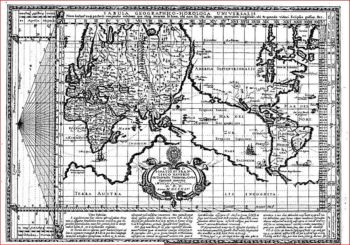
Kino's First Sermon
To The Sobaípuri People of Bac
World Map Shown by Kino
Drawn by Kino's Professor in Europe - Adam Aigenler, S.J.
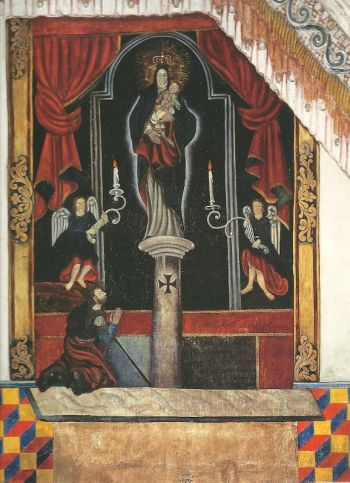
Kino's First Sermon
To The Sobaípuri People of Bac
Appearance of Santa María del Pilar
Before St. James near Compostela, Spain
West Chapel Mural, Mission San Xavier
Kino's First Sermon
To The Sobaípuri People of Bac
"I spoke to them of the Word of God, and on a map of the world showed them the lands, the rivers, and the seas over which we fathers had come from afar to bring them the saving knowledge of our holy faith. And I told them also how in ancient times the Spaniards were not Christians, how Santiago came to teach them the faith, and how for the first fourteen years he was able to baptize only a few, because of which the holy apostle was discouraged, but that the most holy Virgin appeared to him and consoled him, telling him that the Spaniards would convert the rest of the people of the world."
"And I showed them on the map of the world how the Spaniards and the faith had come by sea to Vera Cruz, and had gone in to Puebla and to Mexico, Guadalajara, Sinaloa, and Sonora, and now to Nuestra Señora de los Dolores del Cosari, in the land of the Pimas, where there were already many persons baptized, a house, church, bells, and images of saints, plentiful supplies, wheat, maize, and many cattle and horses; that they could go and see it all, and even ask at once of their relatives, my servants, who were with me."
"They listened with pleasure to these and other talks concerning God, heaven, and hell, and told me that they wished to be Christians, and gave me some infants to baptize. These Sobaípuris are in a very fine valley of the Rio de Santa María, to the west."
Eusebio Francisco Kino
"Journey Northward To The Sobaípuris"
"Favores Celestiales"
August 23, 1692
Editor Note: The world map that Padre Kino showed the Sobaípuri people during the first sermon at Bac was drawn by his professor in Germany, the famous cartographer Adam Aigenler.
Kino recounts the story of Santiago, the apostle St. James the Greater, and his missionary efforts in Spain and how Blessed Virgin Mary (Santa Maria del Pilar) appeared to St. James to tell him not to despair. The Cathedral of St. James in Santiago de Compostela in northern Spain is at the end of the historic and important pilgrimage route called El Camino de Santiago (The Way of St. James). Kino named the valley where Mission San Xavier del Bac is located the valley of the Rio de Santa María del Pilar in honor of Blessed Virgin Mary's appearance to St. James. The valley's name was changed to the valley of the Rio de Santa Cruz in 1787, after the Spanish militarized the frontier 50 years after Kino's death.
Mission San Xavier del Bac, like the Cathedral of Santiago de Compostela, is internationally recognized as a pilgrimage church.
¡ Buen Camino ! — ¡ Buen Camino de Kino !
Journey Northward To The Sobaípuris
Kino's account of his founding Mission San Xavier del Bac
and his first visit to San Pedro River from Kino's "Favores Celestiales"
To view and download, click
Journey Northward To The Sobaípuris document (text)
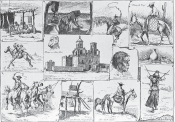
San Xavier - 12 Sketches Frederic Remington
Harpers Weekly April 2, 1887
San Xavier References
A Gift of Angels: The Art of Mission San Xavier Del Bac
by author Bernard L. Fontana and photographer Edward McCain 2012
Sixty-five of 351 pages of this definitive book on the art of the Mission with stunning photography is online.
Click
Fontana's Gift of Angels
HIdden Hispanic Heritage
Online blog by Miguel Peréz at http://www.hiddenhispanicheritage.com/
To view several blogs Miguel by Miguel Peréz that provides incredible interior and exterior photos of the mission along with his personal reflections, click →
47 My Pilgrimage to San Xavier
47 Mi Peregrinaje a San Xavier
69 Keeping My Pledge to San Xavier
Pilgrimage to San Xavier
by Bernard L. Fontana
Arizona Highways
November 1986
This moving article describes the hopes and prayers of people who walk the Camino de Kino pilgrimage trail to the Mission.
For the article's original format, the entire November 1986 issue of Arizona Highways Magazine must first be accessed on the Arizona Memory Project's page for that issue.
Click >
https://azmemory.azlibrary.gov/nodes/view/37202
Arizona Memory Project Access Instructions to Arizona Highways Magazine
Find the issue's table of contents in gray box in center section on left side. Scroll down until you find the article's title. Click on the title. In the upper right corner of the center section click on the icon >> immediately to the left of the title "Descriptive" on the page. Scroll down to fourth item -"Presentation Mode" and then click on it. Then the page will fill the entire screen and you can scroll up or down for adjacent pages.
The Mystery of San Xavier del Bac
by Frank Cullen Brophy
Arizona Highways Magazine
March 1970
Article about the history of the Mission beginning with Kino's founding of the Mission to 1907 when the Franciscans return after 60 years without a resident priest. Kino's writings are used extensively. Many beautiful photographs are presented throughout the issue.
For the article's original format, the entire March 1970 issue of Arizona Highways Magazine must first be accessed on the Arizona Memory Project's page for that issue.
Click >
https://azmemory.azlibrary.gov/nodes/view/22735
See above - Arizona Memory Project Access Instructions
The Sobaípuris - Wider Horizons
Chapter 76
by Herbert E. Bolton
"Rim Of Christendom: A Biography of Eusebio Francisco Kino - Pacific Coast Pioneer" 1936
Bolton's account of Kino's founding Mission San Xavier del Bac and his first visit to the San Pedro River Valley
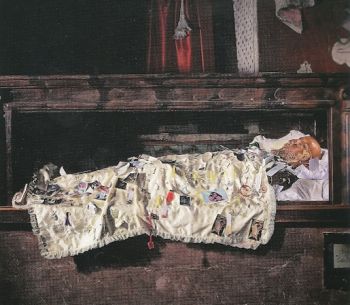
Pilgrims' Prayer Intentions Pinned To
Reclining Statue of St. Franics Xavier
Mission San Xavier del Bac, Arizona
Pilgrimage to San Xavier
Bernard L. Fontana
Arizona Highways Magazine November 1986
To become a pilgrim is to embark on an adventure, to leave the comfort and security of one's home, neighbors, and familiar surroundings as an act of faith. It can be motivated by the need to do penance. It may be Inspired by a sense of thanksgiving. It can be a sacrifice offered in petition.
A pilgrimage must, however, have a sacred place as its goal.
The tradition of pilgrimage is as old as organized religion. And the custom is alive and thriving in southern Arizona where Mission San Xavier del Bac, founded in 1700 by Jesuit missionary Eusebio Kino, has become the magnet for peregrinos, pilgrims, who walk to the mission, hundreds of them each year.
The journey has to be on foot. Driving or riding doesn't count.
The Mission San Xavier we see today was built by Franciscans between the late 1770s and 1797. It is the parish church for Papago Indians who live on the San Xavier Indian Reservation; it is one of Arizona's most popular tourist attractions; and, beginning possibly as early as the last century, it has become a center of pilgrimage for many of the region's Mexicanos or, Americans of Mexican descent who are bearers of a Christian tradition rooted in antiquity.
The mission is located about nine miles south of downtown Tucson. On any day of the week, but especially on weekends, pilgrims make their way south along Mission Road or east along San Xavier Loop Road toward the church. They walk singly, in pairs, trios, or in larger groups. Their heads are uncovered, or they wear wide-brimmed hats, baseball caps, or bandannas. A few wear the religious habit of a saint or sectarian figure. Some carry umbrellas. They may carry water bottles and be without visible logistical support. Or they may walk ahead of a car or truck that will park, then catch up again every few hundred yards. They walk unaided, although some use walking sticks, canes, even crutches.
The pilgrims are of all ages: young children who are hardly more than toddlers, boys and girls, young men, women - some with babies in arms - middle-aged, and elderly. Some stand erect; others are stop shouldered. Some walk briskly; others, idly, playing as they go and aiming rocks at rabbits or birds in the brush beside the road; still others shuffle along, painfully determined to make it all the way to their destination. There are those who laugh, smile, and talk. There are those whose countenances are grim, sad, or reflective and who say little or nothing.
They share a common goal. It is to cover the miles on foot to Mission San Xavier del Bac and, once there, to give thanks to God through one of the saints for a blessing received or to petition for a blessing desired.
For some, the walk is not enough. A few elect to give further evidence of their devotion and added meaning to their sacrifice by going the length of the nave or sometimes all the way from the gate at the atrium in front of the church - on their knees. Fewer still throw themselves flat before the high altar.
Many light votive candles in honor of a particular saint (more than three dozen are represented inside the church by images sculptured in the eighteenth century). Many more affix small metallic votive offerings (milagros), usually in the shapes of afflicted body parts, to the coverlet over the reclining statue of San Francisco lying on an altar in the west chapel.
The majority of these pilgrims are carrying out the terms of a vow (manda) made to God through the intermediary of a saint. Others make straightforward requests.
Notes left beneath burning votive candles in the mission's mortuary chapel during a typical month tell part of the story:
"As que me rínda el dinero St. Lazaro." (Make my money stretch, Saint Lazarus).
Or another in translation: Fairest sainted child Atocha [i.e., Christ who appeared as a child and aided the Christians at the time of the Moorish invasion of Atocha, Spain], we give you thanks for all the favors that we have received from you daily. Thank you, adored Child of Atocha, for having helped my little son J. ···· with his left hand and for his having come out of his two operations well and able to use his little hand Many thanks to you. Child of my heart. I promised to dress him like you and I fulfilled my promise for three months, and now I offer you his habit (a beautifully hand-sewn tunic and cape) in the name of my son J…From now on, you will be his advocate; so take of care him, protect him, and guide him on the right path now and forever. Thank you for your miracles and blessings, sainted Child of Atocha.
And in English, written on the back of a voided personal check: Dear God - I am in so much trouble with the law. Please help me be strong and give me thoughts to help me and my family and friends who are going through this. I'm begging you to please help. I don't want to go to prison. And I don't want to be scarred for life. God help me be out of this and let all this be over real soon.
With nearly equal anguish: Dear Sweet Jesus, Sacred Heart. Here I am asking you please to help me in my life, help me with my divorce. Please!
Don't let me hurt anybody! Help me make a better future for me and my kids. I promise to try very hard. Please be with me all the way. Please help my husband not to hurt so much. Help him, please.
Forgive me my sins. Have mercy on me.
Thank you for every blessing you have given us. Please be with me. Give me strength.
I love you.
And most poignant of all: St. Anthony. Please give my baby back. Please.
Pilgrimage. An act of faith, an expression of deeply held religious convictions. And famous, beautiful Mission San Xavier del Bac is the goal. It is a holy place in which to receive affirmation of one's innermost sentiments, whether of penance, thanksgiving, or petition - a place that provides beauty to the eye and sustenance for the soul.
Dr. Bernard L. Fontana
Pilgrimage to San Xavier
Arizona Highways
November 1986
"Pilgrimage to San Xavier"
For the article's original format, the entire Novermber 1986 issue of Arizona Highways Magazine must first be accessed on the Arizona Memory Project's page for that issue.
To view and download, click →
https://azmemory.azlibrary.gov/nodes/view/37202
See above - Arizona Memory Project Access Instructions
Pilgrimage to Magdalena de Kino
Click for Magdalena de Kino Pilgrimage and other Kino Pilgrimages at
Camino de Kino page.
